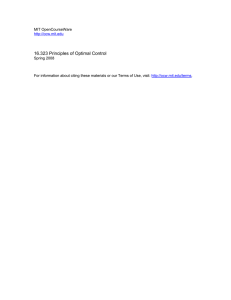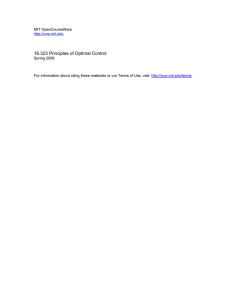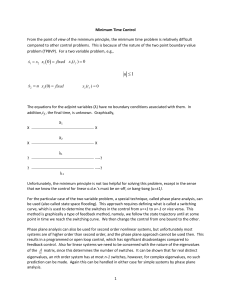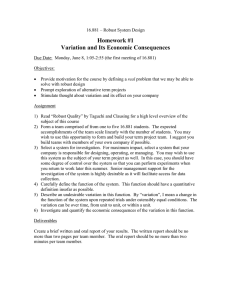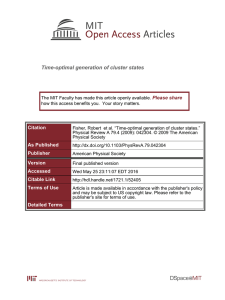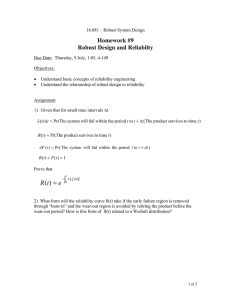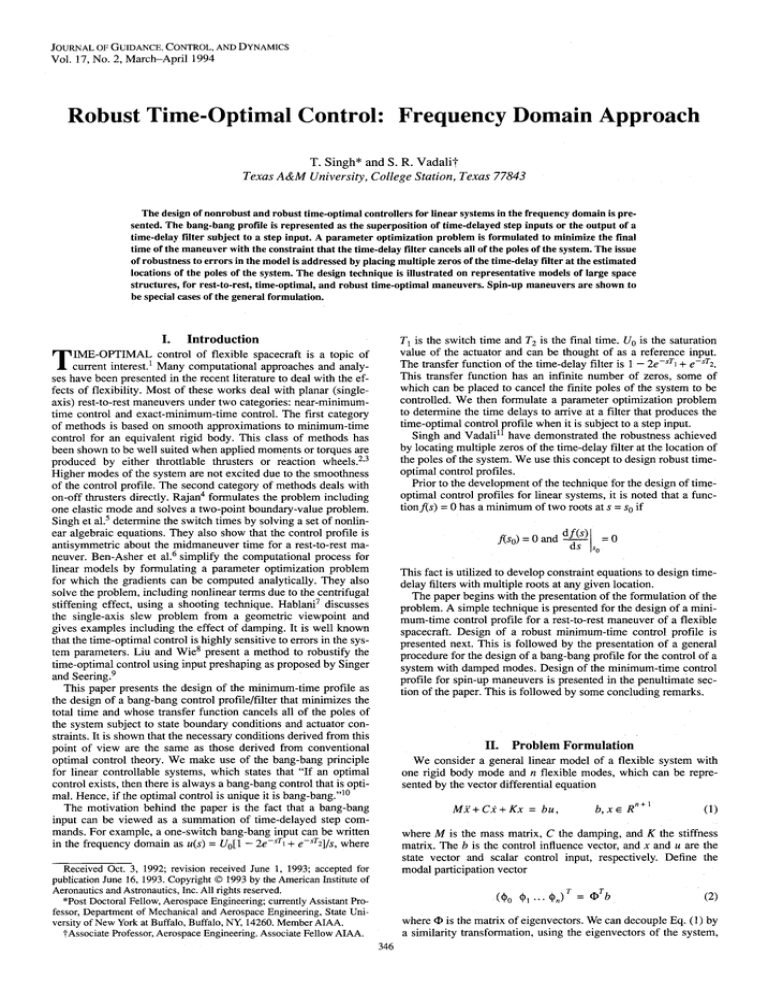
JOURNAL OF GUIDANCE, CONTROL, AND DYNAMICS
Vol. 17, No. 2, March-April 1994
Robust Time-Optimal Control: Frequency Domain Approach
T. Singh* and S. R. Vadalit
Texas A&M University, College Station, Texas 77843
The design of nonrobust and robust time-optimal controllers for linear systems in the frequency domain is presented. The bang-bang profile is represented as the superposition of time-delayed step inputs or the output of a
time-delay filter subject to a step input. A parameter optimization problem is formulated to minimize the final
time of the maneuver with the constraint that the time-delay filter cancels all of the poles of the system. The issue
of robustness to errors in the model is addressed by placing multiple zeros of the time-delay filter at the estimated
locations of the poles of the system. The design technique is illustrated on representative models of large space
structures, for rest-to-rest, time-optimal, and robust time-optimal maneuvers. Spin-up maneuvers are shown to
be special cases of the general formulation.
I.
Introduction
Tl is the switch time and T2 is the final time. f/0 is the saturation
value of the actuator and can be thought of as a reference input.
The transfer function of the time-delay filter is 1 — 2e~sT\ + e~sT2.
This transfer function has an infinite number of zeros, some of
which can be placed to cancel the finite poles of the system to be
controlled. We then formulate a parameter optimization problem
to determine the time delays to arrive at a filter that produces the
time-optimal control profile when it is subject to a step input.
Singh and Vadali11 have demonstrated the robustness achieved
by locating multiple zeros of the time-delay filter at the location of
the poles of the system. We use this concept to design robust timeoptimal control profiles.
Prior to the development of the technique for the design of timeoptimal control profiles for linear systems, it is noted that a function/(s) = 0 has a minimum of two roots at s - s0 if
T
IME-OPTIMAL control of flexible spacecraft is a topic of
current interest.1 Many computational approaches and analyses have been presented in the recent literature to deal with the effects of flexibility. Most of these works deal with planar (singleaxis) rest-to-rest maneuvers under two categories: near-minimumtime control and exact-minimum-time control. The first category
of methods is based on smooth approximations to minimum-time
control for an equivalent rigid body. This class of methods has
been shown to be well suited when applied moments or torques are
produced by either throttlable thrusters or reaction wheels.2'3
Higher modes of the system are not excited due to the smoothness
of the control profile. The second category of methods deals with
on-off thrusters directly. Rajan4 formulates the problem including
one elastic mode and solves a two-point boundary-value problem.
Singh et al.5 determine the switch times by solving a set of nonlinear algebraic equations. They also show that the control profile is
antisymmetric about the midmaneuver time for a rest-to-rest maneuver. Ben-Asher et al.6 simplify the computational process for
linear models by formulating a parameter optimization problem
for which the gradients can be computed analytically. They also
solve the problem, including nonlinear terms due to the centrifugal
stiffening effect, using a shooting technique. Hablani7 discusses
the single-axis slew problem from a geometric viewpoint and
gives examples including the effect of damping. It is well known
that the time-optimal control is highly sensitive to errors in the system parameters. Liu and Wie8 present a method to robustify the
time-optimal control using input preshaping as proposed by Singer
and Seering.9
This paper presents the design of the minimum-time profile as
the design of a bang-bang control profile/filter that minimizes the
total time and whose transfer function cancels all of the poles of
the system subject to state boundary conditions and actuator constraints. It is shown that the necessary conditions derived from this
point of view are the same as those derived from conventional
optimal control theory. We make use of the bang-bang principle
for linear controllable systems, which states that "If an optimal
control exists, then there is always a bang-bang control that is optimal. Hence, if the optimal control is unique it is bang-bang."10
The motivation behind the paper is the fact that a bang-bang
input can be viewed as a summation of time-delayed step commands. For example, a one-switch bang-bang input can be written
in the frequency domain as u(s) = C/0[l - 2e~sT\ + e~sTi]/s, where
= 0and
ds
=0
This fact is utilized to develop constraint equations to design timedelay filters with multiple roots at any given location.
The paper begins with the presentation of the formulation of the
problem. A simple technique is presented for the design of a minimum-time control profile for a rest-to-rest maneuver of a flexible
spacecraft. Design of a robust minimum-time control profile is
presented next. This is followed by the presentation of a general
procedure for the design of a bang-bang profile for the control of a
system with damped modes. Design of the minimum-time control
profile for spin-up maneuvers is presented in the penultimate section of the paper. This is followed by some concluding remarks.
II. Problem Formulation
We consider a general linear model of a flexible system with
one rigid body mode and n flexible modes, which can be represented by the vector differential equation
Mx + Cx + Kx = bu,
b, x e Rn
(1)
where M is the mass matrix, C the damping, and K the stiffness
matrix. The b is the control influence vector, and x and u are the
state vector and scalar control input, respectively. Define the
modal participation vector
Received Oct. 3, 1992; revision received June 1, 1993; accepted for
publication June 16, 1993. Copyright © 1993 by the American Institute of
Aeronautics and Astronautics, Inc. All rights reserved.
*Post Doctoral Fellow, Aerospace Engineering; currently Assistant Professor, Department of Mechanical and Aerospace Engineering, State University of New York at Buffalo, Buffalo, NY, 14260. Member AIAA.
t Associate Professor, Aerospace Engineering. Associate Fellow AIAA.
.«>0 V - - < U r = ^b
(2)
where O is the matrix of eigenvectors. We can decouple Eq. (1) by
a similarity transformation, using the eigenvectors of the system,
346
SINGH AND VADALI: ROBUST TIME-OPTIMAL CONTROL
347
2
-^H
1
time
i
9*»~sTi T
4- ZC
9^"sT2
1 — LK>
sT
9p~
— ZC
' "T
-I- C
p~sT<
time
1
T3
T.
Fig. 1 Time-delay filter.
to the form
2T0
e = <>0ii
/ =
1 tO/2
(3)
where 9 is the rigid body coordinate, qt is the /th modal coordinate,
and a, and O)/ are the /th damping factor and frequency, respectively. We also assume that the control effort lies in the range
-\<u<\
time
(4)
The objective of the controllers is to cancel all poles of the system, with the constraint that the control is saturated at all times.
The design involves selection of time delays of a time-delay filter
whose output for a step input is the time-optimal control (Fig. 1).
Fig. 2 Antisymmetric control profile for a spring-mass system.
in Eq. (5), and equating the real and imaginary parts, we have,
respectively
III. Rest-to-Rest Maneuvers
A. Minimum-Time Control of a Flexible Spacecraft with Undamped
Modes
Many researchers have noted the antisymmetric characteristic of
the minimum-time control profiles designed for rest-to-rest
maneuvers for flexible spacecraft without structural damping.5'6'8
We first show that a control profile that is antisymmetric about the
midmaneuver time leads to a transfer function with two zeros at
the origin of the s plane. Figure 2 illustrates the minimum-time
control profile for an undamped system with the time delays
selected to represent antisymmetry. The transfer function of a
time-delay filter containing 2n + 2 time delays (2n + 1 switches) is
+ 2£ (-I)','
/= i
(8)
and
2 ]£(- \ye~GTi sin (0)7;) + 2(- l)n + le~cT» +1 sin(o)7; + v)
i=i
(5)
A zero of the transfer function is located at s = 0, as Eq. (5) goes to
zero at s = 0. The derivative of Eq. (5) with respect to s is
+ e~2°Tn +1 sin (20)7; + l ) = 0
(9)
As we require the undamped poles of the system to be canceled by
the zeros of the time-delay transfer function, we substitute a = 0 in
Eqs. (8) and (9) and rewrite them, respectively, as
»' (6)
cos(corn+1)
i=i
which has a zero at s = 0. Thus we conclude that Eq. (5) has at least
two zeros at the origin that automatically cancel the rigid body
poles, thus satisfying the velocity boundary condition for a rest-torest maneuver.
To arrive at the equations required to cancel the imaginary poles
of the system, we substitute
(7)
= 0
(10)
= 0
(11)
and
sin(carn+1)
348
SINGH AND VADALI: ROBUST TIME-OPTIMAL CONTROL
To cancel poles at co = +yoc>i, ±y'co2, ... , ±7'cort, we substitute co,
into the coefficient of sin(corrt + 1 ) in Eq. (11), which is the same as
the coefficient of cos (($Tn +1) in Eq. (10), which leads to n equations in n + 1 unknowns, r b T2,... ,Tn + j.
Another equation is derived from the boundary constraint of the
rigid body motion. The response of the rigid body equation to the
antisymmetric control profile at tf = 2Tn + { can be represented
using the boundary conditions
0(0) = 0,
forces the necessary conditions to also be sufficient. To verify the
optimality of the switch times arrived at from the parameter optimization problem, Ben-Asher et al.6 proposed an elegant technique. Consider the first-order system
(18)
x = Ax + du,
The optimal control is given by u(i) = — sgn[drX(f)L where A, is the
costate vector. Furthermore
90y)*0
(19)
(12)
6(0) = 0,
Hence the switching function is
6(^ = 0
dTK(t) =
as
which is equal to zero at the (2n + 1) switch times. Thus A,(0) is in
the null space of the (2n + 1) X (2n + 2) matrix P
(-I)'
(-DX
(20)
dTexp(-ATTl)
(13)
dTQxp(-ATT2)
Equations (10) and (13) represent (n + 1) equations in (n + 1) unknowns. These equations allow multiple solutions. Hence we solve
for the time delays via an optimization problem that is formulated
in the next section.
P =
(21)
B. Parameter Optimization
The time delays for the time-optimal filter are solved using a
parameter optimization technique. Analytical expressions for the
gradients of the cost function and the constraints are used in determining the time delays.
The optimization problem for the undamped system is to minimize the cost function
/ = (tf/2Y =:
(14)
We can determine the null space of P and use that vector as X(0) to
determine ^(t). Since the parameter optimization permits multiple
solutions that satisfy the boundary conditions, the control profile
determined from
(22)
must switch at the predetermined switch points to be optimal.
D. Numerical Example 1
subject to the constraints
To illustrate the proposed control design technique, we consider
the control of a two-mass-spring problem, which has one flexible
and one rigid body mode. The equations of motion are
n
2^(-l)'cos[(a(r n+1 -r,.)] +
1= 1
mx\ + k(x{ — x2) = u
1) = 0 ,
i=
(15)
(23)
mx'2 - k(xl - x2) = 0
1 (-i
(16)
where x\ and x2 represent the displacement of the first and second
masses with respect to some inertial frame. We intend to control
the displacement of the second mass x2 with a control applied to
the first mass. We use m = 1 and k = 1, following Liu and Wie.8
The boundary conditions for the rest-to-rest maneuver are
*!(()) = *2(0) = 0,
Xl(tf)
= x2(tf) = 1
and
(24)
o<7\<r2<r3....<rn
(17)
The antisymmetric structure of the control profile about the midmaneuver time has been exploited to reduce the number of parameters to be determined for an undamped system. For example, we
need to determine n + 1 parameters for the control of an w-mode
system, unlike the previous papers where 2n + 2 parameters had to
be determined.6
The optimization toolbox of MATLAB has been used to solve
the constrained optimization problem.
C. Sufficiency Condition
In this paper we assume that the system model is normal, an
assumption that precludes the existence of singular intervals and
^(0) = ^2(0) = o,
*!(*/) =*2oy) = o
The decoupled equations of motion are
6 = 0.707 Iw
(25)
q + 2q = -0.707 In
and the boundary conditions are
6(0) = 0(0) = 0,
Q(tf) = 1.4142,
q(tf) = 0
(26)
6(0) =
349
SINGH AND VADALI: ROBUST TIME-OPTIMAL CONTROL
The optimization problem to be solved is
E. Robust Minimum-Time Control
min/=(r / /2) 2 =r 2 2
(27)
subject to the constraints
-2cos[co1(r2 - TO] + 1 + cos(co1r2) = 0
0.7071 [272 - (2T2 -
(28)
~ ? ] - 1-4142 = 0
(29)
and
>0
It has been shown in Refs. 11 and 13 that multiple zeros of the
time-delay transfer function at the location of the poles of the system lead to robustness of the controller with respect to errors in
estimated frequency. To add n additional zeros at the location of the
poles of the system, we need an additional n time delays. In addition we need to maintain antisymmetry of the control profile, which
leads to a total addition of 2n time delays. Thus the final robust
control profile has 4n + 2 time delays in the transfer function in
addition to the proportional signal. The time-delay transfer function is
2n
(30)
2]T (-l)'V" ' -2e
The transfer function of the time-delay filter for the time-optimal solution can be shown to be
2n
2 +1
^*-*(2T2n+l-Tl)
"
(32)
+e
I _ 2e - 1 -0026*+ 2^-2. 1089s _ 2e -[2(2.1 089) - 1.0026]*
To cancel the n modes of the plant, we require n zeros of the timedelay transfer function at the location of the n poles of the system,
which leads to n equations
The optimization toolbox of MATLAB,12 which uses the sequential quadratic programming method, was used to arrive at the time
delays. Figure 3 illustrates the evolution of the states of the system
subject to the bang-bang control profile (Fig. 4). The optimality of
the solution is corroborated via the technique detailed in Sec. III.C.
cos(cor 2rt+1 ) = 0,
' 0
0.5
1
1.5
2
2.5
3
3.5
4
4.5
/ = ! , 2,..., w
(33)
5
Fig. 3 Evolution of system states subject to time-optimal control.
Fig. 5 Evolution of system states subject to robust time-optimal control.
0.5
0.5
I
-0.5
-0.5
0
0.5
1
1.5
2
2.5
3
3.5
4
4.5
Time (Seconds)
Fig. 4 Time-optimal control profile for a spring-mass system.
5
3
4
5
Time (Seconds)
Fig. 6 Robust time-optimal control profile for a spring-mass system.
SINGH AND VADALI: ROBUST TIME-OPTIMAL CONTROL
350
12
subject to the constraints
-2cos[co1(r3 - 7^)] + 2cos[o)1(r3 - T2)] -
10
=0
(37)
2(r3-r2)sin[co1(r3 + r3sin(CG1r3) =
(38)
0.7071[2r3 -(2T3 - 711)2+(2r3 - T2)2 -T + T - T]
-1.4142 = 0
0
0.5
1.5
2
2.5
3
3.5
4
(39)
and
Frequency
73 > T2 > T{ > 0
Fig. 7 Magnitude plot of the Bode diagram for the spring-mass system.
(40)
The time-delay filter for the time-optimal solution can be shown
to be
~ 1-6563]*
_
2£>-[2(2.9330)-0.712]s +
^-2(2.9330)5
Figure 5 illustrates the response of the system subject to the
robust bang-bang control (Fig. 6). An increase in the maneuver
time is evident. The robustness of the controller can be gauged
from the smaller amplitude of the Bode plot (Fig. 7) in the vicinity
of the system frequency as compared to the Bode plot for the nonrobust case. This implies that the sensitivity of the overall transfer
function is near zero for a small band of frequencies around the
natural frequency. The performance of the robust control profile,
however, degenerates when the model error is large.
time
Fig. 8 Control profile for a spring-mass-dashpot system.
IV. Minimum-Time Control of a Flexible Spacecraft
with Damped Modes
We derive the additional n equations by forcing the derivative of
Eq. (33) with respect to co to zero
1 = 1 , 2 , . . . , /I
Ben-Asher et al.6 and Hablani7 have noted the lack of antisymmetry of the minimum-time control profile for systems with
damped modes. With that argument in mind, we represent the
transfer function of the time-delay filter acting on a unit step input
to produce the minimum-time control profile for an w-mode system as (Fig. 8)
1+2
(34)
The final equation is derived from the boundary condition of the
rigid body motion
(42)
This transfer function has one zero at s = 0. To force the transfer
function to have an additional zero at s = 0, we require
(43)
(35)
which is the derivative of Eq. (42) with respect to s, to have a zero
at s = 0, which leads to the constraint equation
(44)
The time delays are obtained by solving a parameter optimization
problem with the constraints given by Eqs. (33-35).
To cancel the damped poles
(45)
s = <5i ±70)!, O 2 ±70) 2 ,..., Gn
F. Numerical Example 2
We consider the same example as in Sec. III.D. to illustrate the
robust time-optimal control methodology. The optimization problem to determine the time delays for robust time-optimal control is
(36)
of the system we require
2/1+1
1+2 ^(-l)ie~oTicos(<tiri) + e~°T*'+2
/= i
n + 2)
= 0 (46)
SINGH AND VADALI: ROBUST TIME-OPTIMAL CONTROL
and
351
lers for damped systems. The equations of motion of the system
are
2
' sin(co7;-)
sin(cor2n + 2) = 0
(47)
mx\ +c(xl -x2) + k(xl -x2) = u
(49)
The final constraint is arrived at from the rigid mode boundary
condition
(48)
mx2-c(xl-x2)-k(xl-x2)
=0
The parameters chosen for this numerical example are m = 1, c = 1,
and k - 1. The boundary conditions are the same as Eq. (24). The
decoupled equations of motion are
6 = 0.7071w
where tf=T2n +2.
Minimizing T2n + 2 subject to the constraint equations (44) and
(46-48), we arrive at the 2n + 2 time delays.
To address the robustness issue, we require additional constraints derived by forcing the variation of Eqs. (46) and (47) with
respect to co to zero. We will arrive at the same constraint equations if we forced the variation of Eqs. (46) and (47) with respect
to a to zero. We would require an additional 2n time delays to satisfy the additional constraints leading to a (4n + 2) time-delay filter
for an ft-mode system.
Numerical example 3. We consider a two-mass-spring-dashpot
system to illustrate the technique to design time-optimal control-
(50)
q + 2q + 2q = -0.7071 u
and the associated boundary conditions are
6(0) = 0(0) = 0,
Q(tf) = 1.4142,
q(tf) = 0
(51)
The constrained optimization problem to be solved is
(52)
subject to the constraints
1.2
~G^ cos(co1r3)
1
~°ir4 cos(co1714) = 0
0.8
°^ sin(o>1r1) + 2e~
£ 0.6
w
6 0.4
(53)
T
i sin(co1r3)
(54)
4) = 0
§
V* 0.2
0
0.7071 [(742/2)] - (74 - r^2 + (T4- T2)2 - (T4- T3)2] - 1.4142 = 0
(56)
-0.2
-0.4
and
0
0.5
1
1.5
2
2.5
3
3.5
4
4.5
5
T4 > T3 > T2 > Tl > 0
Time (Seconds)
Fig. 9 Response of a spring-mass-dashpot to a time-optimal control
profile.
(57)
The transfer function of the time-delay filter for the time-optimal solution can be shown to be
I — 2^-1-44045 + 2g-3.368s _ 2^-4.25865 + ^-4.6625
/^g\
1.2
It can also be shown that the transfer function of the robust timedelay filter for the same problem is
0.8
\-2e~L44655 + 2^-3.50055 _ 2^-4.73105 + 2^-5.76415 _ 2^-6.4135
+
^-6.65185
£ 0.4
I
Figures 9 and 10 illustrate the evolution of the system states for the
nonrobust and the robust bang-bang control cases, respectively.
Figures 11 and 12 are the control profiles for the nonrobust and the
robust cases, respectively.
§ 0.2
£
0
-0.2
V. Spin-Up Maneuvers
-0.4
-0.6
2
3
4
5
Time (Seconds)
Fig. 10 Response of a spring-mass-dashpot to a robust time-optimal
control profile.
The method outlined earlier for the design of minimum-time
rest-to-rest maneuvers can be used in the design of a control profile for minimum-time spin-up maneuvers. Unlike the preceding
case, we need to cancel only one pole at the origin of the system
transfer function. It should be noted that since we have one less
constraint as compared to the rest-to-rest case, the sign of the gain
352
SINGH AND VADALI: ROBUST TIME-OPTIMAL CONTROL
and
2cos(corn + 1) -
w + 1-7;.)]
- sin(coTn+1) = 0
0.5
(64)
I
1°
From Eqs. (63) and (64), we have
(65)
-0.5
Finally, to meet the velocity boundary conditions, we need
0
0.5
1
1.5
2
2.5
3
3.5
4
4.5
5
2T
=
Time (Seconds)
(-1)'?,.
Fig. 11 Time-optimal control profile for a spring-mass-dashpot.
(66)
We now have n + 1 equations in n + 1 unknown time delays Tt,T2,
...,Tn +l.
We could address the issue of robustness to errors in estimated
frequency by additional time delays that would place multiple
zeros at the location of the poles of the system. Time-optimal spinup maneuver of a spacecraft with damped modes would destroy
the symmetry of the control profile about the midmaneuver time.
0.5
•s
0
2.5
8
-0.5
l.5
0
1
2
3
4
5
6
7
Time (Seconds)
Fig. 12 Robust time-optimal control profile for a spring-mass-dashpot.
= 0 and has the characteristic of being a mirror image about the
half maneuver time.14
0.5
0.5
+2
i- 2
1
1.5
2
2.5
3.5
Time (Seconds)
(60)
Fig. 13 Response of system to minimum-time spin-up control profile.
To cancel the undamped poles at s = ±/co/, / = 1 to n, we require
n
n
T-) - 2 £ (-\ye-«2Tn + i - ^
2.5
=1
1)
=0
(61)
and
2 ]T (- 1)1'*-*7/ sin (cor,) - 2 £ (- rfe
1= 1
/= 1
0.5
X
(62)
which can be simplified, respectively, to
-0.5
0
0.5
1
1.5
2
2.5
3
3.5
4
4.5
5
Time (Seconds)
(63)
Fig. 14 Response of system to robust minimum-time spin-up control
profile.
SINGH AND VADALI: ROBUST TIME-OPTIMAL CONTROL
1
353
and the robust version for the same is
-
1 _ 2^-0.8354*+ 2^-1 -5 168* _ 2e -[2(2.3627) -1.51 68]*
+ 2e~
- £-2(2.3627)*
(72)
Figures 13 and 14 illustrate the system response to the minimum-time spin-up control profile and the robust control profile,
respectively. Figures 15 and 16 are the control profiles for the two
cases.
0
Control Input
0.5
-0.5
VI. Conclusions
-1
()
0.5
1
1.5
2
2.5
3
3.5
4
Time (Seconds)
Fig. 15 Time-optimal control profile for a spring-mass system.
0.5
Acknowledgment
a
I
*O
Design of time-optimal control inputs for linear systems has
been presented from a frequency domain viewpoint. The design
technique involves minimizing the maximum time delay of a timedelay filter subject to the constraint that the output of the timedelay filter saturates the actuator and the zeros of the time-delay
filter cancel all of the poles of the system. The generic nature of
the design procedure has been illustrated by designing time-optimal control profiles for rest-to-rest and spin-up maneuvers. The
issue of robustness to errors in estimated system parameters has
been addressed by requiring multiple zeros of the time-delay filter
to be located at the estimated locations of the poles of the system.
Control profiles for rest-to-rest maneuvers of systems with one and
two flexible modes have indicated the requirement of three (four)
and five (six) switches (time delays), respectively.
This material is based in part on work supported by the Texas
Advanced Technology Program under Grant 1991/264.
0
References
-0.5
0
0.5
1
1.5
2
2.5
3
3.5
4
4.5
5
Time (Seconds)
Fig. 16 Robust time-optimal control profile for a spring-mass system.
Thus to design time-optimal control, we would have to formulate a
parameter optimization problem with 2n + 1 time delays, unlike
the undamped case, where we were required to determine n + 1
time delays. The sufficiency condition can be checked as described
in Sec. III. C.
Numerical example 4. We study the two-mass-spring problem
(which also represents a flexible spacecraft) described in Sec.
III.D. We require the masses to move at a constant velocity of one
unit in minimum time. The optimization problem to be solved to
arrive at the minimum-time control profile is
(67)
subject to the constraints
- 2 sin [toi(T2- 7\ )] + sin (a>1r2) = 0
0.7071[2r2 - 2(272-
- 1.4142 = 0
T2 > T{ > 0
The transfer function of the time-delay filter is
1 - 2e~l2*lls + 2e~[2(L5755) ~
(68)
(69)
(70)
Scrivener, S., and Thompson, R. C., "Survey of Time-Optimal Attitude
Maneuvers," American Astronomical Society/AIAA Spacecraft Mechanics Meeting, AAS Paper 92-168, Colorado Springs, CO, Feb. 24-26, 1992.
2
Junkins, J. L., Rahman, Z. H., and Bang, H., "Near-Minimum-Time
Control of Distributed Parameter Systems: Analytical and Experimental
Results," Journal of Guidance, Control, and Dynamics, Vol. 14, No. 2,
1991,pp. 406-415.
3
Vadali, S. R., Singh, T., and Carter, T., "Computation of Near-Minimum-Time Maneuvers of Flexible Structures by Parameter Optimization,"
Proceedings of the AIAA Guidance, Navigation, and Control Conference
(Hilton Head, SC), Vol. 2, AIAA, Washington, DC, 1992, pp. 694-704.
4
Rajan, N., "Minimum-Time Slewing of the SIRTF Spacecraft," Proceedings of the AIAA Guidance, Navigation, and Control Conference
(Washington, DC), AIAA, New York, 1987, pp. 1222-1227.
5
Singh, G., Kabamba, P. T., and McClamroch, N. H., "Planar, Time-Optimal, Rest-to-Rest Slewing Maneuvers of Flexible Spacecraft," Journal of
Guidance, Control, and Dynamics, Vol. 12, No. 1,1989, pp. 71- 81.
6
Ben-Asher, J., Burns, J. A., and Cliff, E., M., "Time-Optimal Slewing
of Flexible Spacecraft," Journal of Guidance, Control, and Dynamics, Vol.
15, No. 2, 1992, .pp. 360-367.
7
Hablani, H. B,, "Zero-Residual-Energy, Single-Axis Slew of Flexible
Spacecraft with Damping, Using Thrusters: A Dynamics Approach, Proceedings of the AIAA Guidance, Navigation, and Control Conference, Vol
1, AIAA, Washington, DC, 1991, pp. 488-500.
8
Liu, Q., and Wie, B., "Robustified Time-Optimal Control of Uncertain
Structural Dynamic Systems," Proceedings of the AIAA Guidance, Navigation, and Control Conference, Vol. 1, AIAA, Washington, DC, 1991,
pp. 443-452.'
9
Singer, N. C., and Seering, W. P., "Pre-Shaping Command Inputs to
Reduce System Vibration," ASME Journal of Dynamic Systems, Measurement, and Control, Vol. 112, March 1990, pp. 76-82.
10
Hermes, H., and Lasalle, J. P., Functional Analysis and Time Optimal
Control, Academic Press, New York, 1969.
H
Singh, T., and Vadali, S. R., "Robust Time-Delay Control," ASME
Journal of Dynamic Systems, Measurement and Control , Vol. 115, June
1993, pp. 303-306.
12
Grace, A., "MATLAB, OPTIMIZATION TOOLBOX," The Math
Works, Inc., Natick, MA, pp. 3.9-3.12.
13
Singh, T., and Vadali, S. R., "Robust Time-Optimal Control of Systems Using Delays," International Journal of Control (to be published).
14
Singh, G., Kabamba, P. T., and McClamroch, N. H., "Time-Optimal
Spinup Maneuvers of Flexible Spacecraft," The Journal of Astronautical
Sciences, Vol. 38, No 1, 1990, pp. 41-67.

